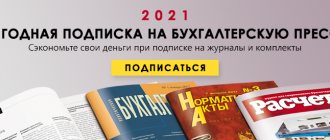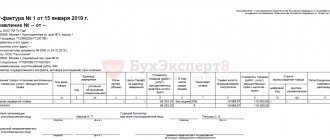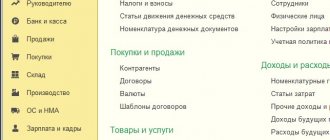The simplified tax system is called simplified compared to the general taxation system - OSN . Significant differences are in taxes. Many entrepreneurs like the simplified taxation system. It suits almost everyone and makes life easier: instead of a bunch of taxes, there is only one, reporting is done once a year, and there are ways to pay less.
Entrepreneurs in both taxation systems pay transport, land and property taxes only if they own transport, land or property.
What is the difference between the taxation system simplified tax system 6% and simplified tax system 15%
The “simplified” options are indicated in Art. 346.14 Tax Code of the Russian Federation. In practice, they are usually called the simplified tax system “Income” and the simplified tax system “income minus expenses”. From now on we will call them “Income” and “Income minus expenses”.
The main difference is clear from the names. With the “Income” option, the tax base is all revenue received by the businessman. Its size is determined “by payment”, i.e. upon receipt of money from customers to the account or cash register. The basic tax rate in this case is 6%.
In addition, a feature of the simplified taxation system “Income” is tax deductions, which will be discussed in more detail below in a separate section.
For the “Revenue minus expenses” option, the base is the difference between revenue and expenses. At first glance, this version of the simplified taxation system resembles the income tax used under the “regular” taxation system (OSNO). But “simplified” in this case has two significant differences from OSNO.
- Income and expenses are determined “by payment”.
- The list of expenses is “closed”. This means that if any expense is not expressly indicated in Art. 346.16 of the Tax Code of the Russian Federation, then it will not reduce the tax base.
There are no deductions when using the “Income minus expenses” object, because all “allowed” expenses already reduce the taxable base.
The tax rate in this case is 15%
Who does not suit the simplified tax system?
Both entrepreneurs and companies can work on the simplified tax system, but with restrictions. If any of these conditions are violated , for example, a company opens a branch or its turnover increases, it will have to switch to a general taxation system.
- Restrictions on the type of activity. Banks, alcohol and cigarette manufacturers, insurance companies, microfinance organizations, pawnshops, outstaffing companies, gambling organizers, notaries and lawyers cannot work on the simplified tax system; professional participants in the securities market: brokers, dealers, securities managers and others from Chapter 2 of Law No. 39-FZ
- Restrictions on organizations. State and budgetary institutions, payers of the unified agricultural tax, participants in production sharing agreements, non-state pension and investment funds, foreign organizations.
- By number of employees. The staff, including employees registered under civil contracts, should not exceed 100 people.
- By turnover. For 2021, companies and individual entrepreneurs can work on the simplified tax system if their turnover does not exceed 150 million rubles per year.
- At the cost of fixed assets. The accounting residual value of fixed assets and intangible assets of a company or individual entrepreneur should not exceed 150 million rubles. However, only property that was purchased at RUR 100,000 or more is taken into account. Rights to computer programs, patents and other intangible assets are not included in the limit. The conditional Startup LLC, which owns the rights to applications in Epstore worth 200 million rubles and three computers worth 500,000 RUR, can work on the simplified tax system.
- By share of other organizations. A company cannot operate under the simplified tax system if other organizations own more than 25% of its authorized capital. If you are a big business with investors, switch to OSN.
- By branches. The company must not have branches.
How to choose a simplified tax system option based on the amount of expenses
So, a businessman has a choice - to pay 6% of all revenue or 15% of the difference between revenue and costs. To understand which simplified taxation system is more profitable, it is enough to solve a simple equation:
(H – W) x 0.15 = H x 0.06
where B is revenue, and C is costs
0.15 x H – 0.15 x W = 0.06 x H
(0.15 – 0.06) x H = 0.15 x W
0.09 x H = 0.15 x W
W = (0.09 / 0.15) x H = 0.6 x H
It turns out that if the planned expenses do not exceed 60% of the revenue, then the simplified taxation system “Income” is more profitable, and if they exceed it, then “Income minus expenses”.
When do you need to pay and send reports using the simplified tax system?
Tax according to the simplified tax system must be paid every quarter:
- I quarter - no later than April 25;
- II quarter - no later than July 25;
- III quarter - no later than October 25;
- IV quarter (for the year) - LLC no later than March 31 of the next year, and individual entrepreneur not later than April 30 of the next year.
This applies specifically to paying money, not filing a declaration.
A tax return under the simplified tax system must be submitted once a year:
- LLC - until March 31
- IP - until April 30
If the deadline falls on a weekend or holiday, it is moved to the next business day.
The declaration is submitted online through an electronic reporting system, taken in person to the tax office, or sent by mail with a list of the attachments.
You also need to keep a book of income and expenses. You don’t hand it over to the tax office until she asks.
Example 1
Revenue is 100 thousand rubles. Then the tax under the simplified tax system “Income” will be equal to:
H1 = 100 x 6% = 6 thousand rubles.
If costs make up 50% of revenue, then the tax under the “Income minus expenses” option will be higher:
H2 = (100 – 100 x 50%) x 15% = 50 x 15% = 7.5 thousand rubles.
If costs amount to, for example, 70% of revenue, then the tax for “Income minus expenses” will already be lower than for “Income”
H2 = (100 – 100 x 70%) x 15% = 30 x 15% = 4.5 thousand rubles.
But not everything is so simple... We also need to take into account the impact of tax deductions.
What tax deductions are provided under the simplified tax system “Income”
The final tax amount under the simplified taxation system “Income” can be reduced by a number of types of costs (Article 346.21 of the Tax Code of the Russian Federation):
- Mandatory insurance contributions from the wage fund.
- Sick leave payments.
- Payments under voluntary insurance contracts in favor of employees.
- Trade fee.
The procedure for applying the deduction depends on the category of businessman and the type of expenses themselves.
| Type of deduction | Legal entities and individual entrepreneurs (IP) with employees | Individual entrepreneur without employees |
| Mandatory and voluntary insurance contributions, as well as sick leave | up to 50% of the tax amount | no limits |
| Trade fee | no limits | no limits |
UTII
Individual entrepreneurs and legal entities can change the taxation system to UTII at their own will. But this opportunity is not provided everywhere. For example, in Moscow this regime does not work at all; in St. Petersburg it is available only with some restrictions.
UTII is available only to persons who are engaged in certain types of business activities ( clause 2 of Article 346.26 of the Tax Code of the Russian Federation ):
- retail;
- catering;
- household and veterinary services;
- repair, maintenance and washing services for vehicles;
- advertising placement and others.
In addition, there are the following restrictions :
- the enterprise should employ no more than one hundred employees;
- the residual value of the fixed assets should not exceed 150 million rubles;
- the share of legal entities among the founders should not be more than 25%.
Subjects paying UTII receive certain benefits. The main one is exemption from paying part of taxes . In particular, in this case companies do not need to pay:
- income tax;
- property tax (there are exceptions);
- VAT.
For entrepreneurs, there is no need to pay personal income tax, VAT and property tax (in terms of its use in business activities).
A special feature of UTII is the immutability of the amount to be paid . The tax does not depend on profit - it is calculated using a formula. However, even if the taxpayer did not make any profit, he is still required to pay this amount. It is best to avoid inaction in such a situation and submit an application for deregistration in a timely manner.
Tax base is the amount of imputed income, which is the product of the basic profitability of a particular type of business, calculated for the tax period, and the value of the physical indicator that characterizes this type of activity. The indicator depends on the type of activity and can be characterized by an employee, a retail location, or a unit of area. The UTII rate is 15% of the amount of imputed income . Basic profitability depends on two coefficients:
- The deflator coefficient ( K1 ) in 2021 is 1.868 .
- Adjustment coefficient ( K2 ), which depends on many factors of doing business, including seasonality and operating hours, assortment and amount of income.
In addition, the amount of calculated tax can be reduced due to certain payments:
- employee insurance contributions;
- sick leave benefits paid by the employer to its employees;
- payments under voluntary insurance contracts for employees.
Taking into account all the above payments, the amount of calculated tax can be reduced by no more than two times . Individual entrepreneurs have the opportunity to reduce the amount of payment due to compulsory health insurance and compulsory health insurance contributions that they paid for themselves.
An entrepreneur who pays taxes according to the imputed system and uses cash register equipment can count on a tax deduction . It is equal to the amount spent on the purchase of this equipment. The costs also include the amounts spent on modernizing the cash register. The maximum deduction amount is 18 thousand rubles for each individual entrepreneur cash register .
It should be noted that this concession can only be used by an entrepreneur who registered cash register equipment in the period from 02/01/2017 to 07/01/2019 (if the individual entrepreneur is engaged in catering or retail trade and attracts employees - until 07/01/2018). The application for the deduction is submitted through a tax return, with the obligatory indication of the amount of expenses associated with the acquisition and modernization of an online cash register.
In order to start working on the “imputation”, a legal entity or individual entrepreneur should submit a corresponding
application to the INFS at the place of business, at the location of the organization (place of residence of the individual entrepreneur). You can change the tax regime from the beginning of the calendar year.
How to take into account tax deductions when choosing the simplified tax system option
The trade tax is currently relevant only for Moscow. Therefore, most “users” of the simplified tax system (except for “micro” entrepreneurs without employees) can reduce the final tax amount by no more than 50%.
In other words, the rate under the simplified tax system “Income” in this case seems to be “reduced” from 6% to 3%.
If we substitute 3% instead of 6% in the equation discussed above, then it is easy to calculate that the “threshold” cost value will be equal to 80% of revenue.
In this case, the amount of deductions is important, or more precisely, its relationship with the amount of the “simplified” tax. If through deductions it is possible to completely “cover” half of the accrued tax, then the simplified taxation system “Income” will be beneficial until costs exceed 80% of revenue. If the amount of deductions is smaller, then “intermediate” options are possible in the cost share range from 60% to 80%.
How to reduce the simplified tax system “Income”
All individual entrepreneurs are required to pay insurance premiums for themselves, their amount is fixed: in 2021 - 32,385 RUR. Contributions can be paid once a year - until December 31, or they can be paid along with the tax according to the simplified tax system, that is, quarterly.
Most often, it is more profitable to pay premiums quarterly: in this case, the amount of the insurance premium for the quarter reduces the base for calculating tax according to the simplified tax system.
Insurance premiums for individual entrepreneurs and employees can be deducted from the tax. To do this, follow the rules:
- Individual entrepreneurs without employees reduce the tax completely, and individual entrepreneurs with employees and all LLCs - only by half.
- Contributions transferred in the same period for which the tax is calculated are taken into account. For example, on March 18 you paid 10 thousand rubles in insurance premiums. By this amount you will reduce the simplified tax system for the first quarter.
Example 2
Revenue – 100 thousand rubles, tax under the simplified tax system “Income” without taking into account deductions is 6 thousand rubles. If the amount of deductions is greater than or equal to 3 thousand rubles, then the final amount of tax payable will be half less than the original:
H1 = 6 x 50% = 3 thousand rubles.
In this case, the simplified taxation system “Income minus expenses” becomes beneficial only if the costs are more than 80% of the revenue, for example
H2 = (100 – 100 x 90%) x 15% = 10 x 15% = 1.5 thousand rubles.
If the amount of deductions is less than half of the tax, for example, 2 thousand rubles, then the tax under the simplified tax system “Income” will be equal to
N1 = 6 – 2 = 4 thousand rubles.
Then the option “Revenue minus expenses” can be profitable even with a smaller share of costs in revenue
H2 = (100 – 100 x 75%) x 15% = 25 x 15% = 3.75 thousand rubles.
The benefits of using each of the objects, taking into account the businessman’s category and the share of costs, are shown in the table
| Share of costs in revenue | up to 60% | from 60% to 80% | over 80% |
| Legal entities and individual entrepreneurs with employees who do not pay the trade fee | "Income" | Depends on the relationship between the amount of tax and the amount of deduction | "Income minus expenses" |
| Individual entrepreneurs without employees and payers of trade tax | "Income" | Depends on the relationship between the amount of tax and the amount of deduction | |
As for individual entrepreneurs without employees and payers of trade tax, the taxation system of the simplified tax system “Income” can be beneficial for them at any ratio of revenue and costs, incl. and in case of losses.
The fact is that for these categories, the “Income” object allows you to “zero” the tax through deductions (of course, if their amount is sufficient for this). And the “Income minus expenses” object in any case does not make it possible to completely free yourself from payments to the budget. Even if a loss is incurred, the businessman is obliged to pay a minimum tax of 1% of the proceeds (clause 6 of Article 346.18 of the Tax Code of the Russian Federation)
How to address the risks associated with cost recognition
We must not forget that the simplified taxation system “Income minus expenses” is associated with more complex accounting and additional risks.
There is always a possibility that counterparties will not provide the necessary documents on time, or that the tax authorities will not accept certain expenses based on the results of the audit.
Therefore, if calculations show that the benefits from using both options are approximately the same, then it is better to choose the simplified taxation system “Income” in order to simplify accounting and reduce risks.
How to switch to simplified tax system
Notification of the transition to the simplified tax system can be submitted immediately upon registration of the company or within 30 days after registration.
To switch to the simplified tax system immediately after registering a company, a notification in form 26.2-1 must be attached to the package of documents.
Existing companies will switch to simplified legislation only from the beginning of next year. The notification must be submitted from October 1 to December 31 of the previous year. That is, it will no longer be possible to switch to the simplified tax system in 2021, but you can submit an application in October and switch to the simplified tax system in 2021.
The Federal Tax Service does not send any paperwork about the transition to the simplified tax system, but you can ask it about it - it’s calmer. To do this, write a request in free form or fill out a special form. In response, the Federal Tax Service will send an information letter.
Important!
Sometimes, when registering new individual entrepreneurs and companies, tax authorities can elegantly forget about the fact that they need to put them on the simplified tax system. Just in case, request an information letter that you have been transferred to a simplified taxation system. Do this immediately after registration or after switching to the simplified tax system in the new year.




